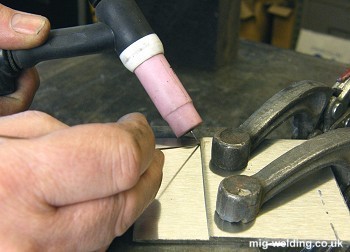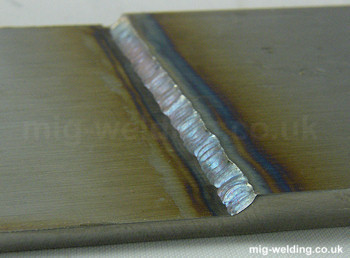TIG Welding Tutorial - Lap Joint
Lap joints are very much like fillet joints. The torch is angled towards the joint at about 40 degrees from vertical (tilt angle), and about 20 degrees from vertical towards the direction of travel (slope angle). The tungsten is aimed at the bottom sheet slightly away from the corner.
The two sheets need to be tightly clamped together to allow heat from the top sheet to dissipate in the bottom sheet. Otherwise the edge of the top sheet will burn away.
The amps are also reduced to help prevent the top sheet from melting back. We're set at 50 amps to weld 2mm stainless and are using 1.0mm filler rod.
The video isn't very clear, but the technique is much the same as a fillet weld - a tight arc and very little filler rod needed.
The video is shot from behind the arc. About 2 thirds of the way through you can see the filler material being sucked behind the arc and freezing at the rear of the weld pool.
The differences between lap joint and fillet joint technique are aimed at increasing the heat in the lower plate and reducing heat in the overlapping plate where there is less steel to dissipate heat. The torch is aimed slightly more towards the lower sheet, the tungsten is aimed onto the lower sheet a small distance from the corner, and the amps are a lot lower than a fillet joint.
The the photo the top edge of the sheet has been burned into slightly. We've used 2mm steel which makes the job very fiddly - the width of the weld bead is only about 3mm.
Lap joints are much easier on 3mm or thicker steel.





